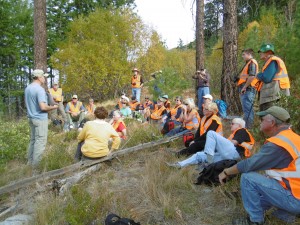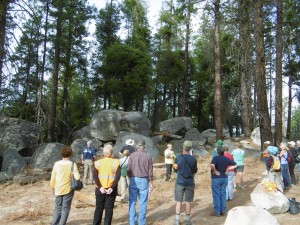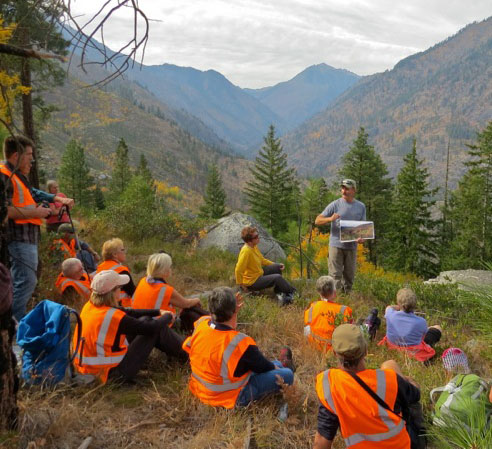Fire Ecology Field Trip a Success
Landscape ecologist Paul Hessburg and biologist/photographer John Marshall hit one out of the park on Saturday as they led 25 mature hikers on a field trip to explore fire ecology. The participants had viewed the museum’s “Wildfires and Us” exhibit and already knew a lot about forest management issues, so Paul and John were able to speak at a somewhat advanced level. People asked great questions! – but weren’t able to stump the experts.
Riding a bus from the museum, we first stopped about a mile up Hay Canyon near Cashmere. We walked to several viewpoints to look at a healthy stretch of dry forest that had recovered nicely from a burn 11 years ago, as is nature’s way. Paul reminded us that wildfire is inevitable in the eastern Cascades. Frequent low-intensity fires clear out forest fuels and don’t hurt big, thick-barked ponderosa pines. When fuels build up, we risk the more catastrophic infernos that bring thick smoke and threaten homes.
Our second bus stop, also with several walking points, was on Mountain Home Ridge overlooking the beautiful Icicle Valley near Leavenworth. John and Paul fielded more questions on fire management strategies, including political issues such as smoke from the prescribed burns that actually lower fire risk by removing small fuels. Paul asked: “How do you want your smoke? A little from prescribed burns, or a lot from huge wildfires?” It’s our hope that officials (and budgets) allow for more of this controlled burning to bring forests better into balance.
Saturday was the beginning of hunting season, so for safety’s sake we donned orange vests (lent by the Department of Transportation’s “adopt a highway” folks) as we ventured through the forest. Good thing, too; there were lots of hunters and rifle shots up Hay Canyon!

 Our last lesson was about mistletoe, a parasite that causes thick “brooms” or excessive growth in Douglas fir trees. See it in the trees behind the rocks in the bottom photo? Mistletoe makes the trees more vulnerable to wildfire.
Our last lesson was about mistletoe, a parasite that causes thick “brooms” or excessive growth in Douglas fir trees. See it in the trees behind the rocks in the bottom photo? Mistletoe makes the trees more vulnerable to wildfire.



